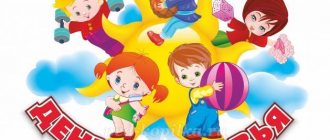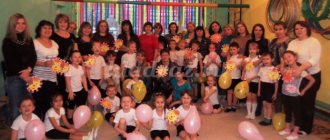Musical and sports entertainment for the preparatory group “Winter Fun”
Municipal autonomous preschool institution
"Kindergarten "Galaxy"
"Winter fun"
(Musical and sports entertainment in the preparatory group.)
Compiled by: Chupina Galina Valerievna, music director,
Goreva Natalya Yurievna, music director,
Bartuli Voldemar Andreevich, physical education instructor.
Target
: To form in children the need for a healthy lifestyle.
Objectives
: • Develop physical qualities: agility, speed.
Ability to perform sports exercises; • Foster a sense of friendship and mutual assistance; • Develop interest in winter games-competitions; • Learn to play in a team, act on a signal and together; • Foster feelings of collectivism and mutual assistance. Equipment
: 2 bags, 2 sleds, 2 dolls, rope;
2 clubs, 2 pucks, cones, artificial snowballs, 2 hoops, 2 baskets, 2 brooms. Characters: Adults
: Presenter, Snowman
Children
Progress of entertainment
:
Cheerful winter music sounds.
Children enter the hall and sit down. Ved.
Guys, today we gathered in our hall to play fun winter games and compete on a frosty winter day.
And our holiday is called “Winter Fun.” But first we need to divide into 2 teams “ICE” and “SNOWFLAKES”. (Children are divided into 2 teams). Ved.
Well, our teams are ready and before the start of the fun competition we will do a fun winter warm-up.
WARM-UP to the song “It’s frosty outside.” Leading:
Well, everything is ready for a fun competition, but we don't have a chief judge. But guess the riddle who will be the judge of our competition today.
He appeared in the yard in cold December. Clumsy and funny, standing by the skating rink with a broom. Our friend is used to the winter wind...
(Snowman
.)
Ved.
That's right, it's the Snowman. And here he comes to us.
(The Snowman enters the hall to the music.) Snowman.
Hello guys. Winter sent me to you to hold winter competitions and see how dexterous and fast you are, and she also asked me to check if you can solve winter riddles. Can you solve riddles? Then listen.
There's a game in the yard in the morning, the kids are playing out. Shouts: “puck!”, “past!”, “hit!” - So there’s a game there -... (Hockey) Every evening I go Draw circles on the ice. Just not with pencils, but with shiny ones... (Skates)
They fly down the hill on their own, But they don’t want to go up the hill. You have to pull the rope up the hill every time. (Sled) Two sticks, two planks. Ride, little people! ( Skis.
)
Snowman.
Well done, you solved all the riddles.
Now let's start our fun competition. 1. Relay race “Jolly Penguins”
. (holding the bag between your legs, you need to run around the pin and pass the bag to the next one).
Evening entertainment “Journey to the world of musical instruments” (preparatory group)
Victoria Alferova
Evening entertainment “Journey to the world of musical instruments” (preparatory group)
Evening entertainment
"Journey into the world of musical instruments"
Goal: the formation of the beginnings of musical and artistic culture, the formation of the child’s creative personality through the development of his musical abilities through listening to classical music. Update children's knowledge about musical instruments.
Tasks:
expand children's knowledge of classical music, develop perception of musical works of different eras;
develop musical abilities, aesthetic taste, the ability to show emotional responsiveness to music, develop creativity and creativity;
introduce children to performing classical music on various musical instruments.
develop visual memory.
cultivate persistence in achieving goals and independence.
Preliminary work: teachers and students studying at children's music school No. 5 in the city of Stavropol were invited to play pieces on various musical instruments. Preparation of the presentation “History of Musical Instruments”.
Equipment: projector, screen, game “Assemble a musical instrument”, music center, selection of classical music, sounds of nature.
Progress:
Children enter the hall and say hello.
Music hands : I’m glad to see you again in the music room. You are in a good mood, cheerful and cheerful. Today we will go on a journey with you. Want to? (children's answer). You all know that trains get ready for their journey at the station, ships raise their sails and leave the harbor for sea, airplanes are equipped at the airport. And you and I will also hit the road. And we will go, and we will go, and we will sail, and we will fly. Our harbor, station, airport will be the music hall. And I invite you on a journey into the world of musical instruments. Here are your seats. Have a seat.
(a fragment of a musical recording sounds, in which various musical instruments sound)
Music hands : Sound, what musical instruments did you hear?
Children list the musical instruments they have heard.
Music hands : Music did not immediately become what we hear it now. Many thousands of years passed before symphonies, sonatas, opera and ballet, jazz, modern songs and rock music appeared.
The world we live in is full of all kinds of sounds. (fragments of the recording are included) The rustling of leaves, the rumble of thunder, the sound of the sea surf, the whistle of the wind, the singing of birds
These sounds were heard by ancient people. He even learned to reproduce them to attract birds and animals. But sounds in themselves are not music.
In time immemorial, man realized that sounds are different: high and low, short and long, muffled and loud, clear. But it was only when he began to connect them in a certain order in order to express his thoughts and feelings in them that music arose. There is no music without musicians. It does not exist without musical instruments.
All instruments can be divided into groups. What groups are these? Please name it.
Children: percussion, brass, woodwind, string-bowed and string-plucked, keyboards, keyboard-wind.
Music hands : What do you think is the oldest “musical instrument” and at the same time is still literally at hand for every person? (answers) This is a human voice. And there was also clapping and stamping of hands. These are the first sounds that people used to accompany dances and rituals.
(show slideshow “History of Musical Instruments”)
(1 slide)
Time passed and musical instruments began to appear, which people made from various scrap materials.
(2 slide)
They made rattles from clay, from dried fruits, inside of which there were pebbles or seeds. Rattles were made from animal bones. And tapping bones on animal skeletons led to the invention of the metallophone. And finally, the drums. Since ancient times, the drum has been used as a signaling instrument, as well as to accompany ritual dances, religious ceremonies, military processions and actions where there would be a need to maintain rhythm, for example, walking, running, pulling, rowing or beating in harmony. It is interesting that the first drums were designed almost the same way as they are now: a hollow body was taken as a basis and membranes were stretched over it on both sides. The membranes were based on the skin of animals and tightened with their own veins, later with ropes, and in our time special metal fastenings are used, which replaced pops, slaps, and stamps, the sounds of which were loud and ringing.
(3 slide)
Sea shells and animal horns make excellent wind instruments.
(4 slide)
On this slide we see wind instruments made of animal bones with drilled holes made of clay and reeds. These guys are a flute or, as they call it in another way, the flute of Pan. The musicians selected several reed pipes according to their height, tied them, glued them with beeswax, and the result was a pipe. The reed became the ancestor of both the shepherd's pipe and the wind instruments of the modern orchestra.
(5 slide)
The string of a hunting bow served as the ancestor of strings - the harp, the violin. These are ancient musical instruments: gusli and gusli.
(6 slide)
Once upon a time, wandering musicians with these folk instruments wandered around Rus', amusing the audience with mischievous songs, tricks, and dances. And imagine that there were musical instruments in the world for the rich and for the poor. There was music of the streets and squares, folk festivals and carnivals; but there was music of luxurious palaces and living rooms. Famous composers composed music for elegant harpsichords, lutes, and viols that belonged to wealthy and educated townspeople. And the folk instruments were played by the musicians themselves, who didn’t even know how to read music. They composed songs and tunes for themselves, made their own instruments and came up with new ways to play them.
Gradually the instruments changed and became more modern. And even in our time, people still continue to invent them.
(7, 8, 9, 10, 11 slides)
To see and hear modern musical instruments live in our hall now, you need to try a little. Ready?
I suggest you play a game: “Assemble a musical instrument”
Children collect pictures and name the resulting tools.
Music hands : You completed the task. Well done! Take a seat, let's continue the journey.
Now close your eyes and imagine that we are in a large concert hall. (classical music sounds) We put on our best suits, beautiful shoes, did our hair, took small theater binoculars with us and, of course, did not forget to buy a bouquet of flowers. Perhaps someone will say: “Are you going to visit?” Of course, for a visit. to Music, to visit Art. And when visiting, it is customary to behave civilly: turn off the sound of your phone at a concert, speak in a whisper so as not to disturb your neighbors, and eat a delicious chocolate bar during intermission, that is, during the break.
Today our guests are young artists from children's music school No. 5. Let's listen to them perform how musical instruments sound live.
Violin. A violin of the string-bow type. She is beautiful and graceful. Her voice is thin and gentle. And she is rightly called the queen of the orchestra! This is the most virtuoso instrument in the orchestra! She is especially good at wide, melodious melodies. And her bow contains only natural horsehair from the horse's mane.
The violin owes its birth to some primitive hunter-genius. A wonderful idea came to his mind: rub two bows with a string against each other, and the result was a sound similar to a human voice. From this time, bowed string instruments began their history.
But years and centuries passed, and the violins changed their original appearance. Thanks to such brilliant Italian violin makers as Amati, Guarneri, Stradivari, they began to look like royalty and acquired a wonderful voice.
An ensemble of violinists sounds.
(Ensemble - when several people play, sing or dance together)
Music hands : Now I will introduce you to a musical instrument! It is greater than all the instruments we will hear today. His name is piano. It crossed three types of musical instruments: the string type, the keyboard type and the percussion type. There is an amazing mechanism inside the piano: many strings of different lengths and thicknesses, wooden hammers of different sizes knock on them, and in order for the hammers to move, you need to press the keys.
Ah, what a lot of keys! There are both white and black here. The piano produces a huge number of sounds - from the lowest to the highest. He can replace a whole orchestra!
The piano was born at the beginning of the 18th century in Italy in the music workshop of Bartolomeo Cristofori. The name means "loud-quiet". And he’s right, the piano can depict a quiet sigh, a breath of a light breeze, a bird’s trill, and then rumble like a raging sea, thunder with a loud voice. Want to hear what a piano sounds like?
The piano sounds
Guitar is a type of plucked string instrument. At first they loved it very much in Spain and began to consider it their folk instrument. Spanish gentlemen sang guitar serenades for their beautiful ladies. There was a guitar in almost every Spanish family. From Spain she moved to Europe, to America, and soon the whole world knew and loved her.
Nowadays the guitar is one of the most common instruments. Any pop ensemble begins with her. When tourists go on a hike, they always take a guitar with them: it’s so pleasant to sing to it in the evening around the fire! You can also hear it in a folk orchestra. It sounds good with balalaika and button accordion. And also in an ensemble with flute, violin, viola.
The guitar sounds.
M.R.: I like the button accordion and its brother the accordion. Both are vocal and so similar! They are often confused if you don't look closely. The accordion only has buttons on one side, and the other has keys, like a piano. And the accordion has buttons on both the right and left. Bayan was “born” in Russia, in the ancient Russian city of Tula at the beginning of the 20th century. It was created by the master of music Pyotr Sterligov and named it by the proud, epic accordion. That is why he has heroic strength. Can play any music, even the most complex. We can play button accordion and accordion not only with simple notes, but with whole chords at once. Therefore, everyone thinks that an orchestra is sounding.
Are you wondering how they make sound?
M.R.: Just like people. You breathe with your lungs, and he breathes with bellows - this is a special mechanical device. If you take a little air into your chest, there will be a quiet, soulful melody. Well, if I take a deep breath from my heart, I can compete with Royal.
Bayan with an accordion is proud of his pedigree. Their mother, the accordion, was born at the beginning of the 19th century in Germany and from there quickly spread throughout the world. They love the harmonica for its cheerful, ringing, iridescent voice. Not so long ago, every village in Rus' had its own accordion player - a very respected person, not a single holiday, not a single celebration took place without him. And if musicians with a tambourine and a drum gathered with an accordion player, it would be a whole concert with songs, dances and ditties.
Our concert has come to an end. Did you like the concert? Let's applaud our artists. Our journey ends. But let's agree that we will return to this wonderful, fascinating world of sounds more than once to continue our acquaintance with music and musicians.





